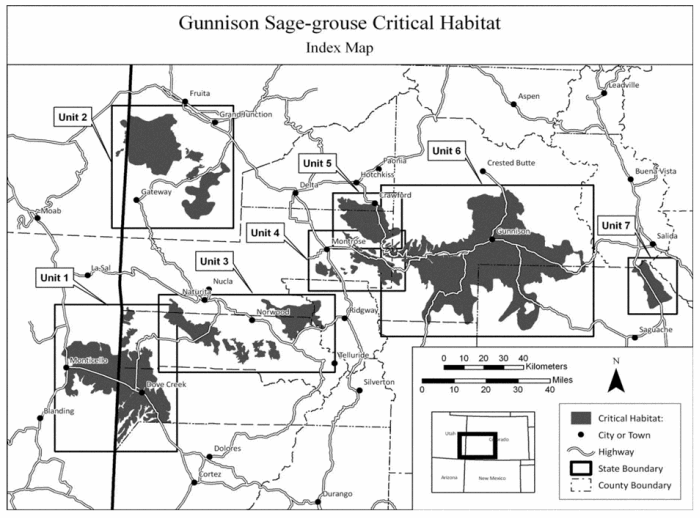U.S. Fish and Wildlife Service Proposes Endangered Status and Critical Habitat for the Gunnison Sage-grouse
by Amy Mowry and Sandi Snodgrass
On January 11, 2013, the U.S. Fish and Wildlife Service (FWS) proposed to list the Gunnison sage-grouse (Centrocercus minimus) as endangered under the Endangered Species Act (ESA).1 In a companion rule, FWS also proposed to designate approximately 1,704,227 acres in Chaffee, Delta, Dolores, Gunnison, Hinsdale, Mesa, Montrose, Ouray, Saguache, and San Miguel counties in Colorado, and in Grand and San Juan counties in Utah as critical habitat for the species.2
The Gunnison sage-grouse is a sagebrush-obligate bird species that is related to the greater sage-grouse and is found in southwestern Colorado and southeastern Utah.3 The Gunnison sage-grouse and the greater sage-grouse were originally considered to be the same species until 2000, when they were recognized as distinct species based on morphological and behavioral differences and geographic isolation.4
FWS listed the Gunnison sage-grouse as a candidate species in 2000 after determining that listing of the species as threatened or endangered was warranted, but precluded by higher priority actions.5 It later determined, in 2006, that listing of the species was not warranted and removed it from the candidate list.6 That determination was challenged in court, and FWS entered into a stipulated agreement under which it agreed to undertake a status review of the species and issue a new determination regarding the species' status.7 In 2009, FWS once again determined that listing of the Gunnison sage-grouse was warranted but precluded, placing the species back on the candidate list.8 In 2011, the U.S. District Court for the District of Columbia approved a settlement agreement that established a multi-year framework for addressing candidate species, including the Gunnison sage-grouse.9 FWS proposed the two new rules as part of that settlement.
In proposing to list the Gunnison sage-grouse, FWS cited loss, degradation, and fragmentation of the species' habitat due to, among other threats, increasing residential, exurban, and commercial development and associated infrastructure development including roads and power lines, which are projected to continue at an increasing rate in the coming years.10 FWS also recognized climate change, grazing, renewable and non-renewable energy development, invasive plants, fire, disease, drought, and recreation as potential threats to the species.11 In proposing the critical habitat designation, FWS identified the primary constituent elements that are essential to the conservation of the species, focusing on various types of seasonal sagebrush habitat.12
A decision to list the Gunnison sage-grouse could have significant consequences for those who live and work in the species' habitat in Colorado and Utah. If the Gunnison sage-grouse is listed, it will become illegal to "take" the species without authorization from FWS.13 "Take" is broadly defined to include activities that harass, harm, or kill a listed species; "harm" is also broadly defined and includes significant habitat degradation or modification which kills or injures wildlife.14 The take prohibition will apply across the species' habitat, regardless of surface ownership. A listing would also require consultation between FWS and federal agencies prior to agency issuance of any permits or authorizations that might affect the Gunnison sage-grouse to ensure that the proposed action is not likely to jeopardize the continued existence of the species or destroy or adversely modify designated critical habitat.15 Actions that are likely to adversely affect the species or critical habitat would be subject to additional restrictions to protect the species and its habitat.
Persons potentially affected by a listing of the Gunnison sage-grouse or designation of its critical habitat should consider commenting on the FWS's proposed rules, including any information regarding the species' population status and trends, effects (or lack thereof) of certain activities on the species, habitat status within the area proposed to be designated as critical habitat, and proposed or existing conservation actions for the species. Conservation efforts are particularly relevant to the listing decision because FWS's Policy for Evaluation of Conservation Efforts When Making Listing Decisions allows the agency to evaluate formalized conservation efforts to determine if those efforts improve the status of the species to the extent that the species is not threatened or endangered. Comments on both rules must be postmarked by March 12, 2013.
View the Gunnison Sage-grouse Proposed Critical Habitat document
View the Gunnison Sage-grouse Proposed Listing document

1 Proposed Rule, Endangered Status for Gunnison Sage-Grouse, 78 Fed. Reg. 2486 (Jan. 11, 2013).
2 Proposed Rule, Designation of Critical Habitat for Gunnison Sage-Grouse, 78 Fed. Reg. 2540 (Jan. 11, 2013).
3 See 78 Fed. Reg. at 2488, 2509.
4 See Notice of Intent to Conduct a Status Review of Gunnison sage-grouse (Centrocercus minimus), 74 Fed. Reg. 61,100 (Nov. 23, 2009).
5 78 Fed. Reg. at 2487.
6 Id.
7 Id.
8 Id.
9 Id.
10 Id. at 2495-2500.
11 Id. at 2500-2515.
12 78 Fed. Reg. at 2546.
13 16 U.S.C. §§ 1532(19), 1538(a)(1).
14 50 C.F.R. § 17.3.
15 16 U.S.C. § 1538(a)(2).
Subscribe to get our Insights delivered to your inbox.
This publication is designed to provide general information on pertinent legal topics. The statements made are provided for educational purposes only. They do not constitute legal or financial advice nor do they necessarily reflect the views of Holland & Hart LLP or any of its attorneys other than the author(s). This publication is not intended to create an attorney-client relationship between you and Holland & Hart LLP. Substantive changes in the law subsequent to the date of this publication might affect the analysis or commentary. Similarly, the analysis may differ depending on the jurisdiction or circumstances. If you have specific questions as to the application of the law to your activities, you should seek the advice of your legal counsel.